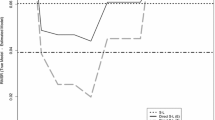Abstract
It is assumed that a battery ofn tests has been resolved into components in a common factor space ofr dimensions and a unique factor space of at mostn dimensions, wherer is much less thann. Simplified formulas for ordinary multiple and partial correlation of tests are derived directly in terms of the components. The best (in the sense of least squares) linear regression equations for predicting factor scores from test scores are derived also in terms of the components. Spearman's “single factor” prediction formulas emerge as special cases. The last part of the paper shows how the communality is an upper bound for multiple correlation. A necessary and sufficient condition is established for the square of the multiple correlation coefficient of testj on the remainingn—1 tests to approach the communality of testj as a limit asn increases indefinitely whiler remains constant. Limits are established for partial correlation and regression coefficients and for the prediction of factor scores.
Similar content being viewed by others
References
Dwyer, P. S. The contribution of an orthogonal multiple factor solution to multiple correlation.Psychometrika, 1939,4, 163–172.
Guttman, Louis. A note on the derivation of formulae for multiple and partial correlation.Annals math. Statistics, 1938,9, 305–308.
Harman, H. H. Systems of regression equations for estimation of factors.J. educ. Psychol., 1938,29, 431–441.
Holzinger, K. J. Estimation of factors. Chapter III,Student Manual of Factor Analysis. Chicago: Department of Education, 1937, pp. 29–41.
Jackson, Dunham. The trigonometry of correlation.Amer. math. Monthly, 1924,31, 275–280.
Ledermann, Walter. Shortened method of estimation of mental factors by regression.Nature, 1938,141, 650.
Ledermann, Walter. On a shortened method of estimation of mental factors by regression.Psychometrika, 1939,4, 109–116.
Roff, Merrill. Some properties of the communality in multiple factor theory.Psychometrika, June, 1936,1, 1–6.
Spearman, C. The abilities of man, appendix. New York: Macmillan, 1927.
Thomson, Godfrey. Some points of mathematical technique in the factorial analysis of ability.J. educ. Psychol., 1936,27, 37–54.
Thomson, Godfrey. Methods of estimating mental factors.Nature, 1938,141, 246.
Thurstone, L. L. The vectors of mind. Chicago: Univ. Chicago Press, 1935.
Thurstone, L. L. Primary mental abilities.Psychometric Monographs Number 1. Chicago: Univ. Chicago Press, 1938.
Author information
Authors and Affiliations
Additional information
I am indebted to Professor Dunham Jackson for helpful criticism of most of this paper.
Rights and permissions
About this article
Cite this article
Guttman, L. Multiple rectilinear prediction and the resolution into components. Psychometrika 5, 75–99 (1940). https://doi.org/10.1007/BF02287866
Issue Date:
DOI: https://doi.org/10.1007/BF02287866




